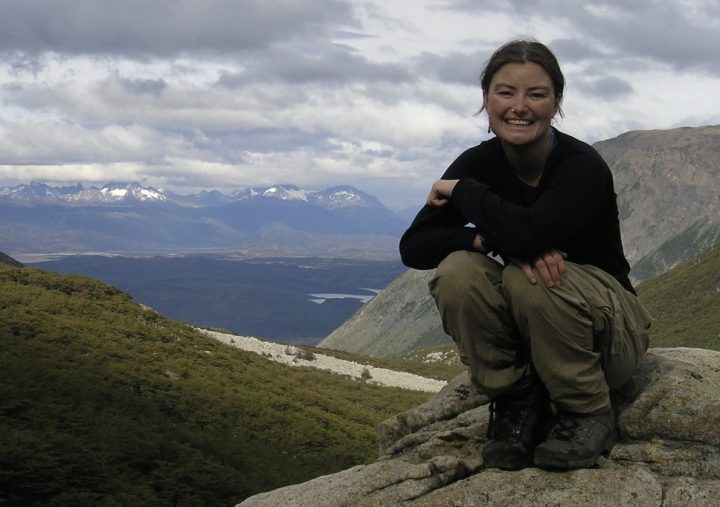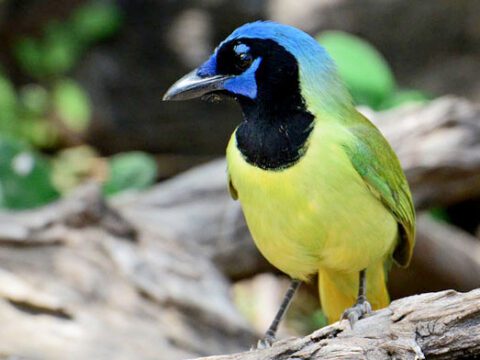Field Research: Connect with Clark’s Nutcrackers
By Hugh Powell April 14, 2011

For anyone who feels spring has been taking its time this year, here’s a post from graduate student Taza Schaming, who as of late March was still skiing through four feet of snow to study Clark’s Nutcrackers in Wyoming:
“Today I drove up to the site near Triangle X Ranch. It was lightly snowing, but pretty warm (in the low 20s) when I snowshoed out to the suet feeders. There were coyote tracks along the top of the ridge and below the suet. They must have been confused to find the food hanging in the trees instead of on the ground. Moments after I set up my nets, I could hear coyotes howling to the north and answering from the south. I hoped they wouldn’t be back until long after I left tonight. Within minutes of me setting up the net, two Gray Jays were eating at the fat, and chickadees were swooping down onto the suet baskets.”
For Taza’s Ph.D. research, she uses nets to catch Clark’s Nutcrackers and attach radio transmitters. The devices allow her to learn how the birds use their alpine habitat—one that is under assault by a variety of ecological menaces. (The devices don’t harm the birds and are safely attached in just a few minutes of handling). In a lively blog for our Crossing Boundaries teacher-outreach project, she describes her day to day work as well as the larger goals that keep her in the mountains, data sheets in hand. For example, in this post written as she kicked off her season:


“After four months on campus at Cornell, then 2,200 miles of driving, I’m back in Jackson, Wyoming, and really excited to be carrying out my Clark’s Nutcracker research again. It feels great to be back in the mountains. I’m here for eight months, and I feel lucky knowing that I’ll be heading out into the woods all day, almost every day, whether it’s snowing and –10°F or pouring rain or hot and buggy. I do what I do for three main reasons: one, I love science and I really enjoy learning firsthand about how the world works, two, I want to do my part to help better conserve biodiversity, and three, I just plain love to be outside.
“I’m in the third year of my Ph.D. research at Cornell, studying how the decline of the whitebark pine trees is impacting Clark’s Nutcracker population and behavior in the Greater Yellowstone Ecosystem. The whitebark pines are disappearing throughout the western United States, including in Greater Yellowstone, due to a mountain pine beetle epidemic and infections from white pine blister rust, an invasive pathogen.
“This year, my goal is to radio track at least 36 nutcrackers and carry out nutcracker surveys in different habitats. I want to find out if Clark’s Nutcrackers can survive and reproduce if the whitebark pines (one of their favorite foods) decline or disappear. In order to figure this out, I’m evaluating which habitats nutcrackers use throughout the year, what they eat in different seasons, how big their home ranges are, and if the number of offspring nutcracker pairs have is different in different habitats. I know this seems like a lot of questions, but they are all intertwined, and collecting data on everything is not too much harder then collecting data on just one of these questions. Answering these questions is important because it will help us protect and conserve nutcrackers and their habitats.”
The Crossing Boundaries project connects teachers and classrooms with work being done in the field by graduate students who work on birds, fish, and amphibians. You can follow the entire project, and see additional blogs and video interviews about the other graduate students, at the Crossing Boundaries website. It’s a great teaching resource to explore.
Taza will be in Wyoming all the way through snowmelt, mud season, the heat of summer, and quite possibly for next season’s first snowfall, which in the Tetons can happen in August. But being in the woods with “her” nutcrackers is how she likes it, as you’ll find out if you follow her blog.


All About Birds is a free resource
Available for everyone,
funded by donors like you






